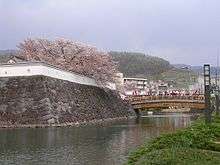Maizuru Castle Park

Maizuru Castle Park is a park and historical site in Kofu, Yamanashi, Japan. It contains the ruins of Kōfu Castle (甲府城 Kōfu-jō), also called Maizuru Castle, which is about 400 years old and has been designated as a Yamanashi Historical Site. Maizuru Castle Park is a place of rest and relaxation for the people of Yamanashi Prefecture.
History of Kōfu Castle
After the Takeda family succumbed, Kai Province became the fiefdom of Oda Nobunaga. When Oda died it came under the governance of Tokugawa Ieyasu. When Toyotomi Hideyoshi unified the country, he ordered the castle's construction. It was begun in 1583 and later completed by Toyotomi's brother-in-law, Asano Nagamasa, and his son. After the Battle of Sekigahara, Kōfu Castle fell into the hands of the Tokugawa family to whom it belonged until the end of the Tokugawa shogunate.
In the early Edo period, Tokugawa Tsunatoyo became the heir of the fifth Shogun, and moved to Edo Castle. Yanagisawa Yoshiyasu then became the Lord of Kōfu Castle. Under his command the castle was fully repaired and the town was also developed. However, Yanagisawa was transferred and became the Lord of Yamato Kōriyama Castle. In the Kyōhō period which followed, Kai Province within which Kōfu Castle was situated came under the control of a retainer stationed in Kōfu. Also during this period, the honmaru of the palace and the Akagenenmon gate were destroyed by a large fire.
Later in the Meiji period the castle was abandoned; around 1877, major buildings of the castle were destroyed. Thereafter the castle area was used as an industrial testing facility. In 1897 it was decided the Yakatakuruwa and Shimizukuruwa Enclosures should be dismantled to make way for Kōfu Station. In 1904 the area around the honmaru was opened to the public as Maizuru Castle Park and in 1930 the Government Offices and Assembly Hall moved to the dismantled lot of the Gakuyakuruwa Enclosure. The western and southern moats were completely buried, and the appearance of the castle ruins became almost the same as they are seen today.
Two of the towers have been reconstructed using traditional techniques, and contain museum displays about the castle and some original artifacts.
References
Coordinates: 35°39′55.04″N 138°34′16.82″E / 35.6652889°N 138.5713389°E